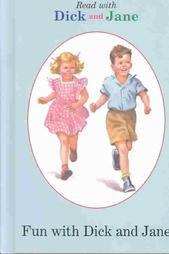Dick and Jane
Dick and Jane are the two protagonists created by Zerna Sharp for a series of basal readers written by William S. Gray to teach children to read.
Although the Dick and Jane series of primers continued to be sold until 1973 and remained in use in some classrooms throughout the 1970s, they were replaced with other reading texts by the 1980s and gradually disappeared from school curricula.
Despite criticisms of the stereotypical content that depicted white, middle-class Americans and despite the "whole-word" or "sight word" (look-say) method of teaching reading on which these readers are based, they retain cultural significance for their impact on literacy education in the mid-twentieth century.
[2][3][4] Gray's research focused on methods to improve reading instruction using content that would be of interest to children and develop their word-recognition skills.
[5] Zerna Sharp, a former teacher, came up with the idea for what became the Dick and Jane readers for elementary school children while working as a reading consultant and textbook editor for Scott Foresman.
In addition, Sharp developed the main characters of "Dick" and "Jane", the older brother and sister in a fictional family that included "Mother", "Father", and a younger sister named "Sally", their pets, "Spot" (originally a cat in the 1930s, but a dog in later editions), and "Puff", their cat; and a toy teddy bear named "Tim".
[10] William Gray and Zerna Sharp worked together to develop readers that incorporated the whole-word or look-say method of word recognition (also called sight reading).
[6][7][8] The texts and illustrations for the Dick and Jane primers were intended to work together to help young readers understand the story.
Because the primers were intended for nationwide distribution, the text and illustrations intentionally lacked references to specific regional geographical features such as mountains, rivers, lakes, plains, or the seashore.
In lower grades French language versions also were issued in the 1950s in Canada, with the main characters renamed Jeanne, Paul, and Lise in these editions.
[8] For this reason, the Dick and Jane readers came to be used less and less as overuse of systematic phonics replaced the more effective method of foundational literacy skills.
[17] According to the history of the Institute for Juvenile Research, psychologist Marion Monroe developed methods for early childhood reading programs, which led to the Dick and Jane stories.
[20] In Why Johnny Can't Read (1955), author Rudolf Flesch concluded that the whole-word (look-say) method was ineffective because it lacked phonics training.
In addition, Flesch was critical of the simple stories and limited text and vocabulary in the Dick-and-Jane-style readers that taught students to read through word memorization.
[20][8] Flesch and other critics also believed that the look-say method did not properly prepare students to read more complex materials in the upper grade levels.
[20] Harold Henderson asserted in his book Let's Kill Dick and Jane (2006) that the series focused on trivial aspects of reading and left children far behind their peers in Europe.
[23] In the late 1950s and early 1960s, critics of the Dick and Jane readers began to point out its stereotypes; class, gender, and racial bias; and errors in content and illustrations.
[25][26] The primers that made the characters of "Dick", "Jane", and "Sally" household words have become icons of mid-century American culture, as well as collectors' items.
